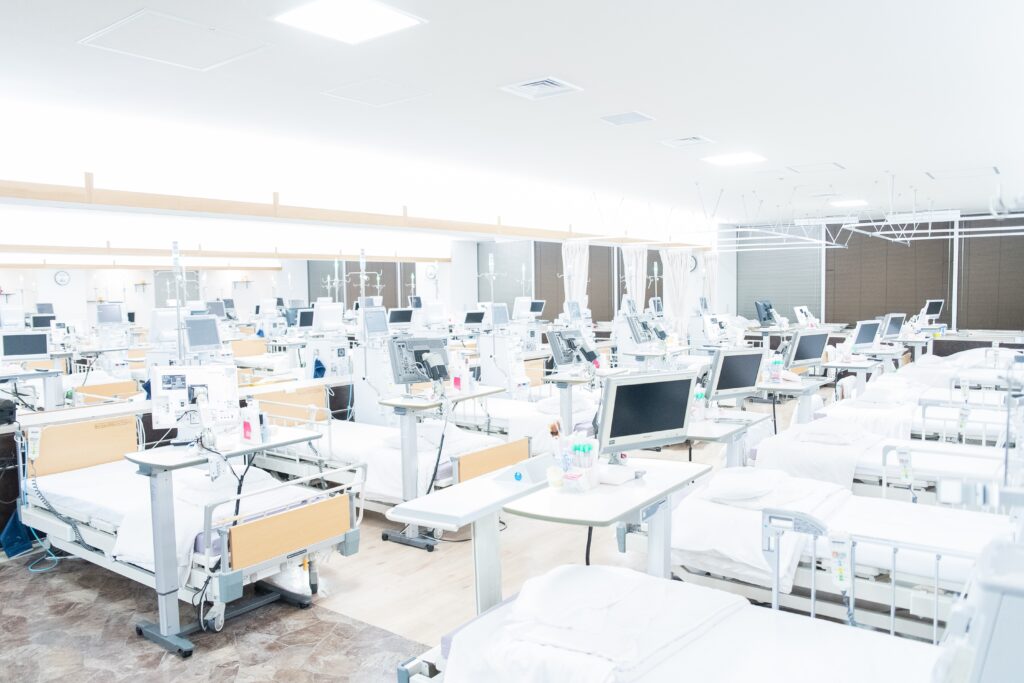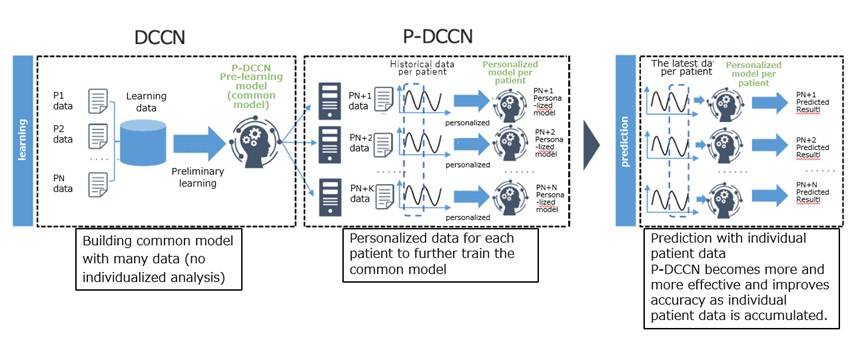Development status
Software as a Medical Device (SaMD) Utilizing Artificial Intelligence for Supporting Maintenance Hemodialysis
In maintenance hemodialysis treatment, blood is drawn from the body, and after correcting electrolytes and removing waste products and unnecessary water (dehydration), the cleaned blood is returned for circulation. The maintenance hemodialysis is necessary to maintain life in patients with chronic renal failure.
Approximately 350,000 patients with maintenance hemodialysis need to undergo hemodialysis three times a week (4 to 5 hours per treatment) for the rest of their lives in Japan. In addition, each dialysis hospital treats dozens of patients with a small staff of one doctor and several nurses and clinical engineering technicians, and when adverse events occur on some patients, the staff is overwhelmed with the burden of dealing with such patients. Furthermore, the medical cost of dialysis exceeds 1 trillion yen, making it a major health care economic burden.
Current Treatments and Challenges
In hemodialysis treatment, “appropriate water removal” is the most important medical issue and setting the dry weight (DW: the patient’s body water in the proper state) and appropriate amount of water removal is the most difficult task for physicians. Insufficient water removal can impair cardiopulmonary function, and excessive water removal can lead to adverse events such as hypotension during dialysis, bad mood, and loss of consciousness. When adverse events occur due to inappropriate water removal, healthcare professionals are overwhelmed with the burden of dealing with such patients. The setting of the appropriate amount of water removal is a highly specialized task, and although dialysis specialists (experienced nephrologists) make comprehensive assessments of patient conditions and use their experience (tacit knowledge) to set the appropriate amount that minimizes adverse events. However, there are not enough dialysis specialists in Japan, and unexperienced physicians often work in rural areas or at night. In many dialysis facilities, unexperienced physicians, experienced nurses, and clinical engineers assist in setting water amount under the direction of a few dialysis specialists.

We decided to utilize artificial intelligence (AI) to develop an AI that mimics the dialysis specialists’ settings of appropriate water removal by learning the tacit knowledge of the specialists.
This AI will enable unexperienced physicians to perform hemodialysis at a level similar to that of the dialysis specialists and reduce the occurrence of adverse events with the assistance of AI.
Characteristics of Our Solutions
We have been creating the AI in collaboration with academia and medical institutions such as Tohoku University and St. Luke’s International Hospital, as well as NEC Corporation to develop software as a medical device (SaMD) to assist unexperienced physicians to perform dialysis treatment at the specialist level.
Based on the Dual-Channel Combiner Network (DCCN), the AI engine jointly developed with NEC, we have developed the dialysis-specific AI by learning 720,000 dialysis patient information obtained from multiple medical institutions including St. Luke’s International Hospital.
DCCN can automatically provide a target amount of water removal on the dialysis day based on the last five dialysis information and other patient records. This AI supports unexperienced physicians to set the target amount of water removal with the same accuracy as the dialysis specialists. In addition, this AI can reduce the occurrence of hypotension during dialysis by setting an appropriate dehydration amount, and can also be a powerful tool to solve problems at dialysis hospitals with insufficient human resources.

Progress to date
At present, our AI can predict the target amount of water removal prescribed by a specialist with an error of about 130 ml, and the AI can predict the probability of blood pressure drop during dialysis (below 20 mmHg) before the start of dialysis with an accuracy of AUC 0.91. In addition, as a result of generalization performance verification using data from 16 facilities, it was evaluated by specialists as having sufficient clinical significance. In February 2023, it was selected for the AMED “Medical Device Development Promotion Research Project (representative institution: Tohoku University, our company is a collaborating institution)” and clinical performance test for regulatory approval application have been conducted since October 2024. In addition, with the aim of commercializing this AI program medical device, we signed a joint research agreement with Nipro Corporation in October 2022 and are developing a system to implement it in clinical settings. In addition, we have begun development of an AI installed in hemodialysis equipment that controls the amount of water removal and blood flow during hemodialysis, and signed a joint development agreement with Toray Medical Co., Ltd. in December 2023.